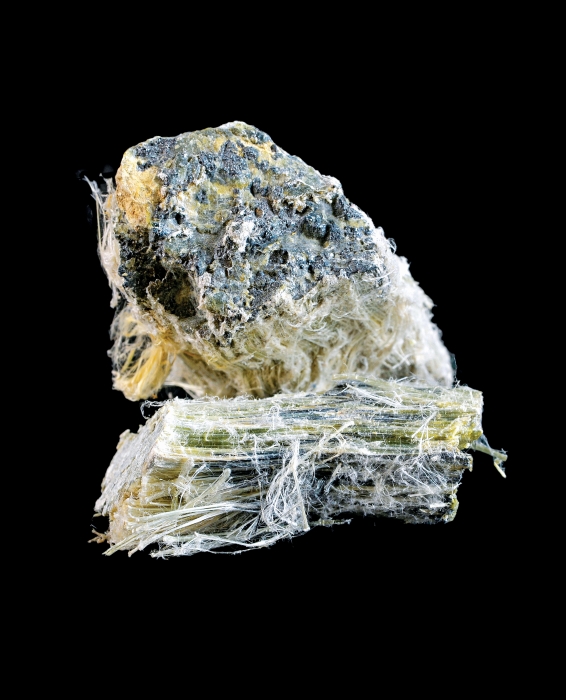Asbestos
Asbestos has also been used in a wide range of manufactured goods, mostly in building materials (roofing shingles, ceiling and floor tiles, paper products, and asbestos cement products), friction products (automobile clutch, brake, and transmission parts), heat-resistant fabrics, packaging, gaskets, and coatings
Common Industrial and Commercial Asbestos-Containing Products
Industrial and commercial asbestos products were used by many different types of trade workers in a variety of industries, including power generation, oil and gas, construction, automotive repair, plumbing, electricity and chemical production.
Construction workers were exposed when building homes, plumbers are exposed to asbestos pipes and insulation, electricians are exposed while repairing electrical panels and other equipment, and auto mechanics are exposed when changing brakes and clutches. Do-it-yourselfers who perform repairs on older homes and home auto mechanics handling aftermarket brake pads and clutch linings are also at risk of asbestos exposure.
Some of the most common asbestos products:

A mechanic removes asbestos-contaminated dust from brakes.
Automotive Parts
Brake pads, clutches, hood liners, gaskets and valves contained asbestos.

Tiles and adhesives at one time were made with asbestos.
Tiles
Flooring, ceiling and roofing tiles were commonly made with asbestos. The adhesive used to lay down flooring tiles has also been a source of exposure.

Weathering of cement made with asbestos can expose toxic fibers.
Cement
Asbestos-containing cement was used in building materials because the fibers provided strength without adding much weight. Its insulating and fire-resistant properties also made the mineral an ideal substance to add to cement.

A variety of textile products were made with asbestos fibers.
Textiles
Asbestos was used in the production of cloths and garments for its resistance to heat and corrosive elements. Some of the most common textiles included blankets, firefighter suits and rope.
The U.S. Environmental Protection Agency’s 2020 risk evaluation found an unreasonable risk to the health of chloralkai workers who handle raw asbestos to make diaphragms. The asbestos diaphragms work as a filter to produce chlorine and sodium hydroxide. Asbestos reportedly does not end up in the final products, so the agency did not find a threat to consumers.
In February 2021, the U.S. Geological Survey reported a 30% increase in raw chrysotile asbestos importation for the previous year to support the chloralkai industry.
The use of asbestos-containing products stretched across a number of industries. Most of the products could be categorized as either construction or automotive materials.
Industrial and Commercial Asbestos Products
Automotive parts
Cement
Construction mastics & gunning mix
Diaphragms
Duct connectors
Electrical components
Felt
Fireproofing
Gaskets
Textiles
Tiles
Home and Consumer Asbestos Products
Appliances
Cigarette filters
Potholders
Ashtray coasters
Wicking for gas ranges
Fake snow
Hair dryers
Talcum powder
Zonolite insulation
Asbestos was used for its ability to strengthen and fireproof materials, including concrete, bricks, fireplace cement, pipes and insulation. Although the use of asbestos has been largely phased out since the 1980s, it can still be found in products such as gaskets and brake pads.
Until the 1800s, people mainly used asbestos to make fireproof cloth in small amounts. Then, during the Industrial Revolution, great demand arose for a material that could insulate steam engines. At the same time, the technology was developed to easily mine asbestos and combine it with other materials.
During the 20th century, demand for asbestos products was propelled further by the shipbuilding efforts of World War II and the postwar building boom. Many veterans were exposed to asbestos during both their military service and their civilian careers.
By the 1970s, lawsuits were holding asbestos manufacturers liable for the diseases their products caused. Workers who developed mesothelioma, lung cancer and asbestosis were suing for compensation to cover medical costs and lost wages. Unfortunately, doctors are still searching for a cure for every type of asbestos-related disease.
Why Was Asbestos Used in Products and Materials?
Asbestos has unique chemical and physical properties that make it strong and resistant to heat and chemical reaction. Its chemical composition makes it less likely to react with other compounds, and the space between its fibers reduces conduction of heat, making it resistant to fire.
Properties of Asbestos
Abundant: Asbestos occurs naturally in mineral deposits around the world.
Fibrous: Asbestos ore can be pulled apart into a wooly consistency and then worked like any other type of fiber.
Durable: Asbestos is resistant to heat, electricity and chemical corrosion.
Carcinogenic: Microscopic asbestos fibers are not easily broken down by the human body once they are inhaled. Over many years, lodged asbestos fibers can cause chronic inflammation, buildup of scar tissue and cancer.







